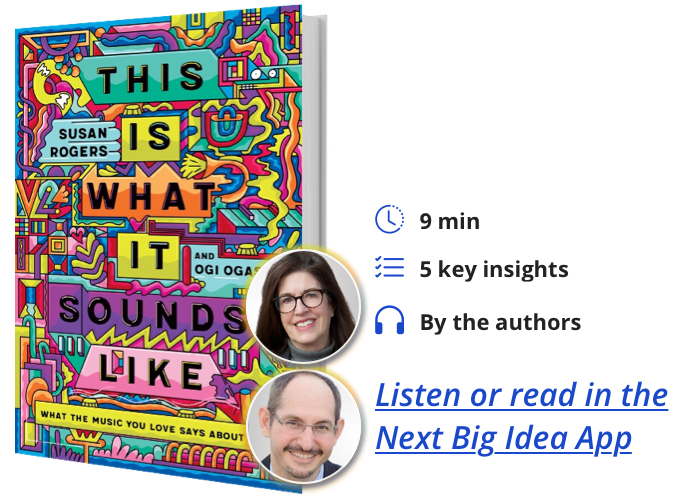Susan Rogers is a record producer, audio engineer, and cognitive neuroscientist who teaches music production and engineering at Berklee College of Music. She was formerly artist Prince’s staff engineer, but now her career is dedicated to the study of music perception. Ogi Ogas is a mathematical neuroscientist and author. He is Director of the Dark Horse Project at Harvard Graduate School of Education, where he studies how individuals achieve success.
Below, Susan and Ogi share 5 key insights from their new book, This is What It Sounds Like: What the Music You Love Says About You. Listen to the audio version—read by co-author Susan—in the Next Big Idea App.
1. Listening is not the same as hearing.
Listening to music—attending to what works and doesn’t work in a song, feeling its rhythms and melodies as if they were a part of your body, like your fingers and hips—is an indispensable component of music. By perceiving, feeling, and reacting to the many dimensions of a song, a listener closes the creative circle and completes the musical experience.
Becoming a “musical” listener requires curiosity, effort, and love. But it also requires understanding and embracing your unique identity as a music listener. Everyone has a Listener Profile—the brain response to music that is as unique to each one of us as our taste in food or fashion or romantic partners.
2. There are multiple dimensions to music listening.
Neuroscience describes seven aesthetic and musical dimensions that can each independently provide a pleasurable reward from music listening. Through these dimensions, you can discover your Listener Profile. These seven dimensions are:
- Authenticity—the subjective impression of how genuine and sincere the music feels. Where do the expressive performance gestures seem to come from: perhaps the performer’s head, maybe it’s coming straight from the heart, or hips?
- Realism—the opposite of abstraction. Realistic records are played on actual instruments, familiar enough to picture in your mind’s eye. Abstract records are created on virtual instruments that exist only in computer code. Do you prefer music played on instruments that you know or do your listening rewards come from virtual instruments that fire up your imagination?
- Novelty—your perception of music’s originality. Some listeners prefer familiar musical forms that let them savor nuanced arrangements or virtuoso technique, while other listeners prefer being challenged by musical innovation and stylistic daring.
“Becoming a “musical” listener requires curiosity, effort, and love.”
- Melody—music evolved to reflect humans’ emotional lives. Melody does the heavy lifting of transmitting a feeling. Melodies can be sweet, bitter, soaring, driving, poignant, cheerful, rousing, or any human emotion. We can think of melody as a record’s heart.
- Lyrics—this dimension can be thought of as the mind of a record because lyrics express ideas. You may prefer songs with plainly spoken truths or you may listen for poetic constructs. You may enjoy vivid imagery in lyrics or have a fondness for more conceptual writing.
- Rhythm—music’s hips. Moving to music is an irresistible urge for most people; it starts when we are toddlers. What kind of rhythm compels you to dance?
- Timbre—sound itself. This is the unique sonic portrait that distinguishes among individual instruments and voices. We may call timbre the face of a record because timbre establishes music’s identity and genre. Some prefer a lush orchestra, others a jazz trio; some prefer acoustic twang, others a wall of electric guitars.
3. Your Listener Profile is characterized by seven “sweet spots”—one per dimension.
Think of a sweet spot as a “Goldilocks zone” of resonance. It arises from a sense that this record is just right for you. We seek different kinds of rewards from music listening. The record you choose at any given moment most likely matches your sweet spot on one or more of the seven dimensions. Our musical sweet spots exert a powerful gravitational pull on our thoughts and feelings, leading to a greater release of pleasurable neurotransmitters.
4. The music you love best can activate your default network—a neural system in the brain that is activated whenever we daydream and think creatively.
The default network is part of our sense of self: our self-identity and self-awareness. Listening to music you love activates your default network, which means that music can serve as a personal guide to private places in your mind where only you can go.
“A journey into your Listener Profile is a journey in self-discovery.”
Getting more familiar with your Listener Profile helps you dive deeper into your own desires, fantasies, and creativity, those mental places where you can try on other identities to discover the “music of you.” A journey into your Listener Profile is a journey in self-discovery.
5. Falling in love with a record is like falling in love with a person.
This instant attraction that can be hard to explain. Sure, you acknowledge that not everyone loves your playlist as much as you do. They may even wonder what you hear in the songs that you hold dearest. But no one should ever be a music snob, nor a music wallflower. Everyone’s taste is valid.
This Is What It Sounds Like hopes to answer questions about your musical loves that you didn’t think to ask. Getting better acquainted with the music you love will deepen your relationship with music and with yourself.
To listen to the audio version read by co-author Susan Rogers, download the Next Big Idea App today:






























